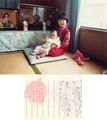Hina Matsuri (Doll Festival)
ひな祭り
ひなまつり
A festival for girls held on the third of March, the Doll Festival is celebrated by setting up a tiered display of dolls representing the ancient imperial court. Resplendent in ancient court dress are the emperor and empress, their attendants, and court musicians. Peach blossoms complete the display along with diamond-shaped rice cakes (hishimochi) and a creamy-white, mildly alcoholic beverage called shirozake (made of rice malt and sake), is served to family and friends. The Doll Festival is also known as the Peach Festival (Momo no Sekku).
The origins of the Doll Festival go back to the Heian period (794-1185) when dolls were floated down a river to pray for the good health and safety of children. Known as nagashi-bina, this custom is still practiced in some regions of Japan. The tiered display of dolls most popular today first appeared in the Edo period (1600-1867).
Hina doll displays vary widely in price according to the number of dolls and the number of tiers. The most expensive sets can cost more than one million yen, but the most popular sets cost around 200,000 yen. A full display consists of seven tiers, with 15 dolls and a miniature display of the empress's dowry furniture. The dolls are, from top to bottom: the emperor and empress, three female attendants (sanninn kanjo), five court musicians(gonin bayashi), two court ministers(zuishin), and three court attendants(jicho). The seven-tiered display can be quite large (some as large as 150 x 200 x 189 cm), and smaller displays consisting of just the royal pair or a simple three-tiered arrangement of emperor and empress, the three female attendants, and miniature furniture are proving to be better suited to the restricted space of the contemporary Japanese home.
|

my_p02 |

my_p02_2 |

sm_p02 |

sm_p02_2 |

ok_p07 |
|